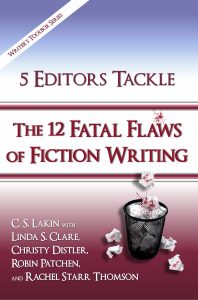The 12 Fatal Flaws of Fiction Writing and How You Can Correct Them
This year, I, along with four other editors, have been going deep into the fatal flaws of fiction writing on Wednesdays. We hope you’ve been enjoying all the posts and benefiting from all the many discussions and examples we’ve shared. The response from readers has been wonderful, and it’s our hope you’ve been learning much to help you spot the fatal flaws and fix them.
The best way to benefit from this huge amount of content is to have it all at your fingertips for easy access. As with the other courses I’ve taught on Live Write Thrive the last few years, we have compiled and reworked these blog posts, added a truckload of additional material and Before and After passages, put in checklists and bonus passages, and created this new writing craft book in The Writer’s Toolbox Series.
We believe this book will be an invaluable resource for every fiction writer, and you can preorder it now as a Kindle ebook here! The print book will release with the ebook on December 1. If you’re looking for holiday gifts for your writer friends, look no further!
Here’s a peek at the introduction of our new book . . .
 Fiction writers often struggle to improve their craft. They want to write better, more effectively. Tell a stronger, more evocative story. But oftentimes what a writer envisions in her mind doesn’t come across on the page.
Fiction writers often struggle to improve their craft. They want to write better, more effectively. Tell a stronger, more evocative story. But oftentimes what a writer envisions in her mind doesn’t come across on the page.
The biggest challenge can come from the inability to see what isn’t working. The prose feels off. The scene just isn’t gelling. The dialogue sounds stilted or clunky. Writers consult their stack of reference books or jump online and search for answers on blog posts. They may even travel long distances to attend workshops and conferences to get to the heart of their problems.
But even then, the solutions are often elusive.
What writers need are not more books and instructors telling them what to do and how to do it. They need examples. And not just examples of great fiction writing. They need examples of weak, flawed writing too.
What helps writers most is to read passages that demonstrate flawed writing, then be shown revisions that target specific flaws and offer clear, effective solutions to those problems.
12 Fatal Flaws
When working on a manuscript, editors mark up and revise sections to show writing clients what’s not working, why, and how these passages might be rewritten. We believe this is the best way to help writers identify their specific weaknesses, as well as learn how to get mastery over them.
Not every writer can afford to hire an editor to point out a manuscript’s flaws. And wouldn’t it be better for writers to arm themselves with the knowledge and skills needed to avoid succumbing to these writing flaws in the first place? We think so.
That’s why we five editors put together a year-long course online—on the Live Write Thrive blog—specifically aimed at tackling the most problematic issues we see day in and day out as we edit and critique manuscripts. While there are undoubtedly more than twelve “fatal flaws” of fiction writing, we set out to examine in depth the most troublesome and ubiquitous of these.
We refer to these issues as fatal flaws because of their potential to cause “novel failure.” Any one of these twelve flaws, if prevalent in a novel or other work of fiction, can be a writer’s undoing. And because there is no one way to fix each flaw, we’ve created multiple examples to expose each one, using passages written in a variety of genres, points of view, and writing styles. We feel this wide assortment of more than sixty examples provides just the help writers need.
In addition to being editors, we are all novelists—who struggle with these fiction flaws like any other author. We hope that by sharing our decades of experience as writers as well as book editors, we might help you seek and destroy the fatal flaws in your writing.
How to Best Benefit from This Book
As you read each entry, try to identify what’s wrong in the Before passage. Consider jotting down your observations in a notebook, paying special attention to the sections that apply most to your own writing issues. If you have a print copy, you may want to mark up these sections.
Pay attention to how the fatal flaw is presented and what solutions are offered to fix it. At the end of each chapter you’ll find a checklist of the points covered—what you need to search for in your scenes or stories to ferret out the fatal flaw. You’ll also get a bonus passage to work on, to help you test what you’ve learned (with a sample “correct” passage provided on the next page). We suggest you copy and print out these passages and work on them before peeking at the sample solution on the following page.
Every writer has a unique style and approach to fiction writing, so we hope that by reviewing a wide spectrum of examples, you will be able to spot potential weaknesses in your writing and fix them.
So as we tackle the twelve fatal flaws of fiction writing, jump in and take them on with us. If you’re still having problems with specific flaws, consider hiring an editor with fiction-writing experience to help you home in on your weak areas and give you the skills to self-edit your work effectively. There’s no reason any writer should have to experience novel failure.
Learn How to Self-Edit
It can’t be emphasized enough: it’s so important for writers to become brutal self-editors. Order 5 Editors Tackle the 12 Fatal Flaws of Fiction Writing and get those flaws exposed and fix them. You and your readers will be glad you did!
Photo Credit: katy_nicolson via Compfight cc












Ambiguity is just so delightfully hazy…… “This year, I, along with four other editors, have been going deep into the fatal flaws of fiction writing on Wednesdays.” The question begs: don’t fatal flaws occur on any other day of the week?
They sure do! That’s why I didn’t say “the fatal flaws that occur on Wednesdays!”